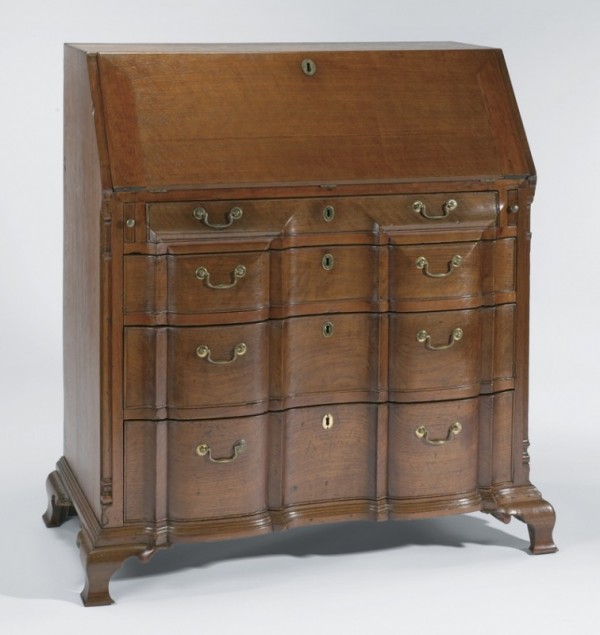
Desk attributed to the WH cabinetmaker, northeast, North Carolina, 1780–1790. Walnut with walnut and yellow pine. H. 47 3/4", W. 46", D. 22 5/8". (Courtesy, Virginia Museum of Fine Arts; photo, Katharine Wetzel.) This desk was found in Halifax, North Carolina.
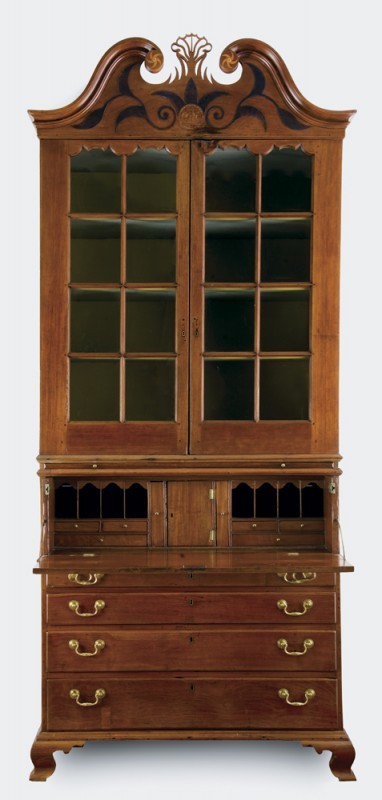
Secretary press attributed to the WH cabinetmaker, northeast, North Carolina, 1785–1795. Walnut with walnut, yellow pine, and oak. H. 110 1/4", W. 48 1/4", D. 22." (Courtesy, Historic Hope Foundation; photo, Gavin Ashworth.)
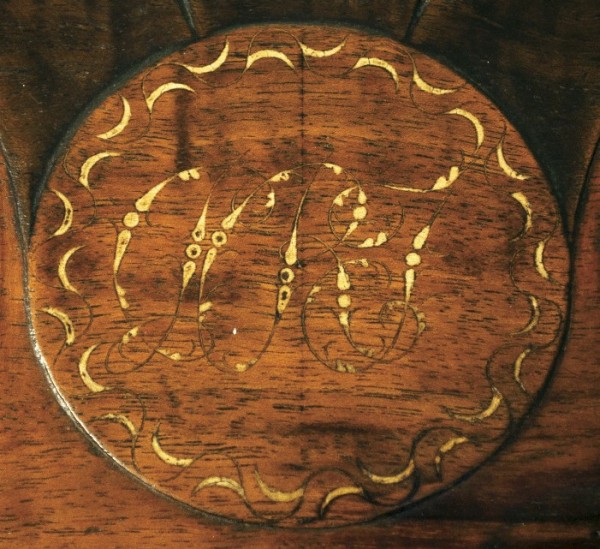
Detail of the monogram from the secretary press illustrated in fig. 2. (Photo, F. Carey Howlett).
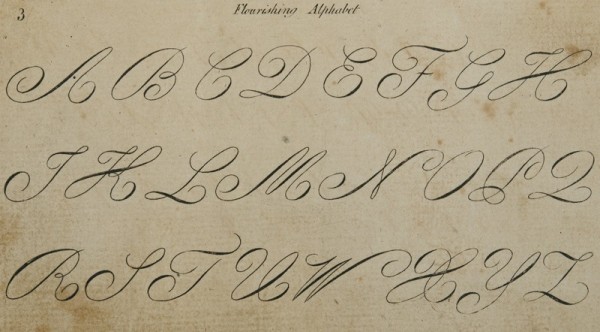
“Flourishing Alphabet,” from George Fisher, The Instructor, or American Young Man’s Best Companion. . . . (Worcester, Mass.: Isaiah Thomas, 1786), pl. 3. (Courtesy, Massachusetts Historical Society.)
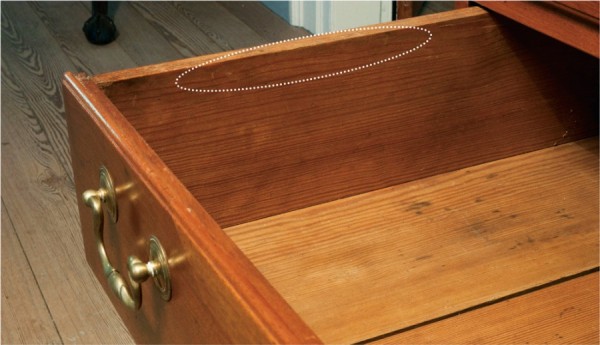
Detail of the secretary press illustrated in fig. 2, showing the location of the inscribed names. (Courtesy, Historic Hope Foundation; photo, F. Carey Howlett.)

Raking-light image of the inscription on the secretary press illustrated in fig. 2 (Courtesy, Historic Hope Foundation; photo, Gavin Ashworth.)
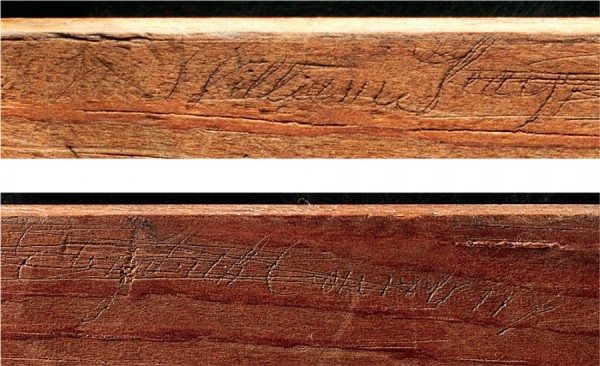
(Top) A portion of the inscription illustrated in fig. 6 showing the name “William Seay” viewed using Reflectance Transformation Imaging (RTI) rendered in static mode. (Courtesy, Historic Hope Foundation; photo, Travis Fullerton.) (Bottom) A portion of the inscription illustrated in fig. 6 showing the name “Elizabeth Cou[illeg.]” viewed using Reflectance Transformation Imaging (RTI) rendered in unsharp mask mode. (Courtesy, Historic Hope Foundation; photo, Travis Fullerton.)

Signature of William Seay on an indenture document for Joel Bird, May 11, 1774. (Courtesy of the North Carolina Office of Archives and History, Raleigh, North Carolina.)
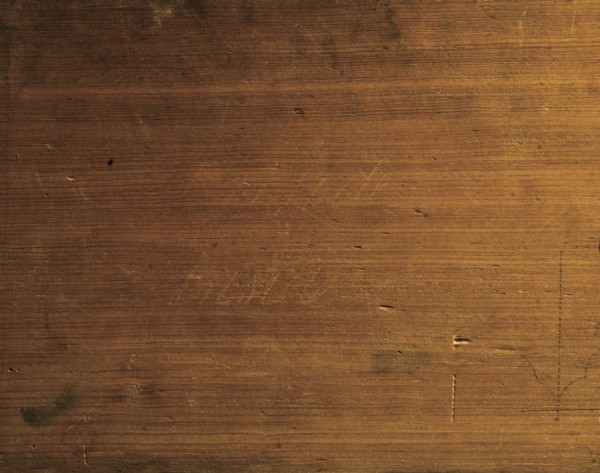
Chalk inscription on the inner face of the proper right side of the bottom drawer of the secretary press illustrated in fig. 2. (Courtesy, Historic Hope Foundation; photo, Travis Fullerton.)
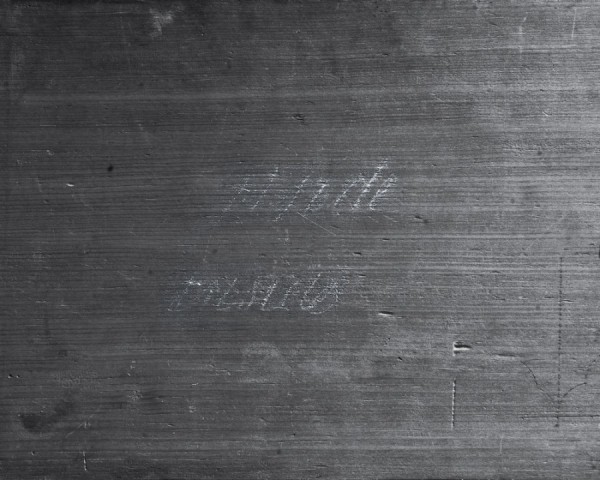
Cross-polarization photograph of chalk inscription illustrated in fig. 10 converted to black and white and enhanced with Adobe Photoshop. (Photo, Travis Fullerton.)

Secretary press attributed to the WH cabinetmaker, northeast, North Carolina, 1785–1795. Walnut with yellow pine and walnut. H. 107 1/2", W. 44 3/4", D. 22 1/2". (Courtesy, Chrysler Museum of Art; photo, Gavin Ashworth.) This press descended in the Smithwick family of Hartford County, North Carolina.
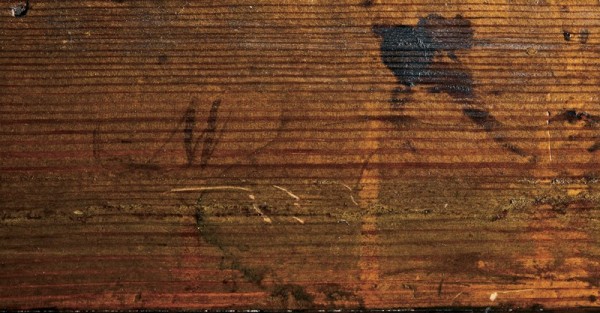
Inscription on the top of the lower case of the secretary press illustrated in fig. 12. (Courtesy of the North Carolina Office of Archives and History, Raleigh, North Carolina. Photo, Gavin Ashworth.)

Inscription illustrated in fig. 13 viewed using cross-polarization to search for additional evidence of ink. (Photo, F. Carey Howlett.)
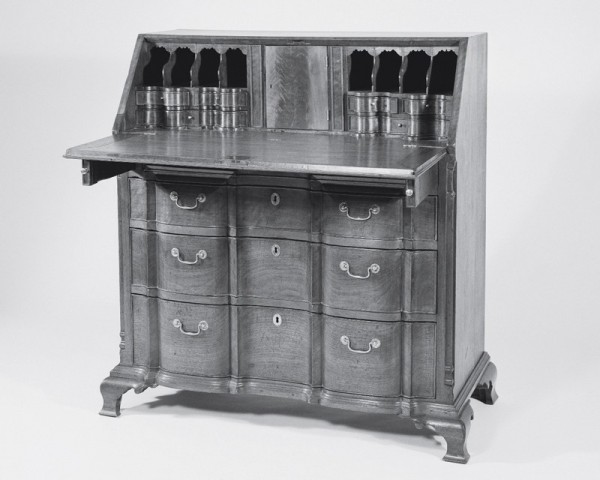
Desk illustrated in fig. 1 with fallboard open. (Courtesy, Virginia Museum of Fine Arts.) Furniture scholar John Bivins published this image in a section on the WH cabinetmaker in The Furniture of Eastern North Carolina.
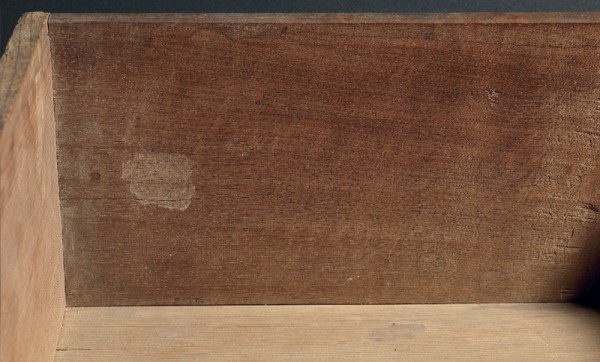
Raking side-lit cross polarized image of the inner face of the bottom drawer of the desk illustrated in fig. 1. No chalk is present, although the sloping wavy figure of the walnut resembles handwriting. (Courtesy, Virginia Museum of Fine Arts; photo, Travis Fullerton.)

Wavy figure is not visible in a raking top-lit cross polarized image of the same view as fig. 16. The surface reveals jackplane marks but no presence of chalk. (Courtesy, Virginia Museum of Fine Arts; photo, Travis Fullerton.)
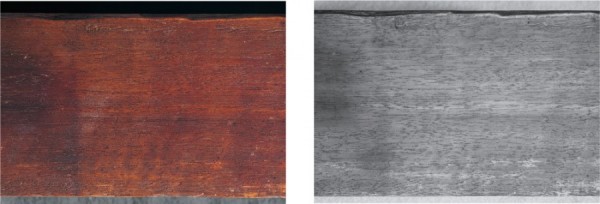
Standard photograph (left) of the wavy figure on one of the lid supports of the desk illustrated in fig. 1. No ink is visible. (Photo, Travis Fullerton.) A second image using reflected ultraviolet photography (right) demonstrates that no ink is present.

Standard photography (left) of the outer surface of the side of the bottom drawer of the desk illustrated in fig. 1 reveals a series of angled scratches and a reflected ultraviolet image (right) shows no evidence of an ink inscription. (Photo, Travis Fullerton.)
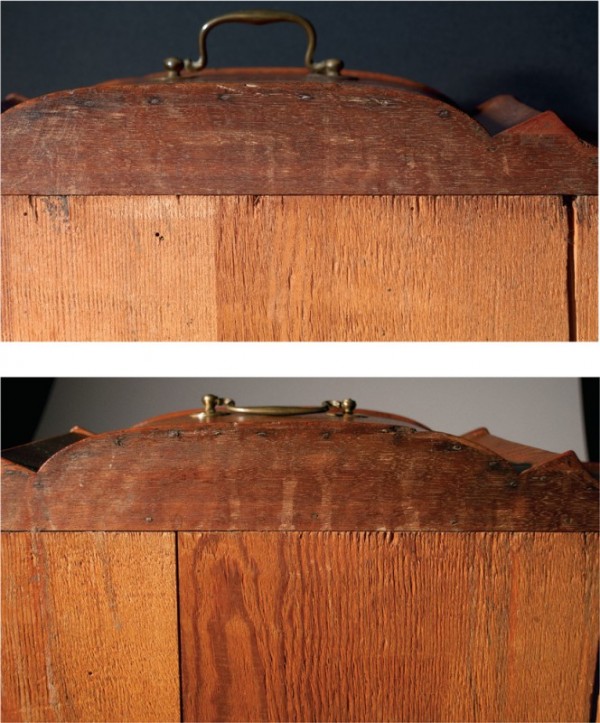
Standard photograph of the bottom edge of the bottom drawer of the desk illustrated in fig. 1 reveals blanched surface drips associated with refinishing rather than the initials “TBH.” A second image (bottom) shows similar drips on another drawer. (Photos, Travis Fullerton and F. Carey Howlett.)
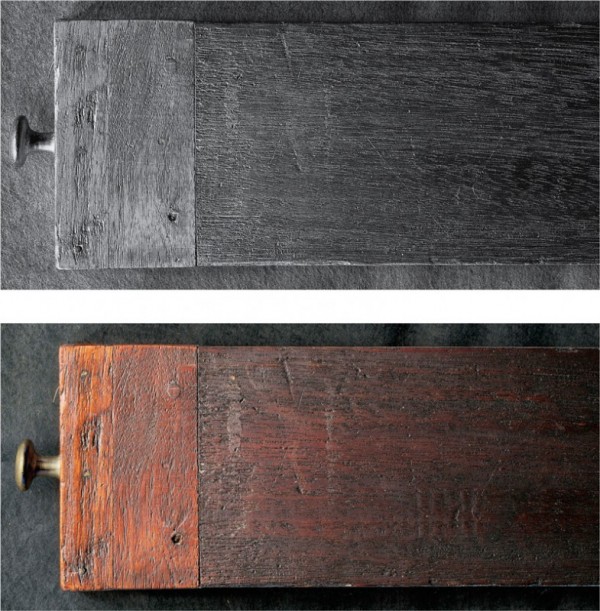
(Top) A photo captured using Reflectance Transformation Imaging (RTI) in image unsharp mask mode showing an uneven six-legged zigzag scratched into a lid support of the desk illustrated in fig. 1, clearly not handwriting. (Photo, Travis Fullerton.) (Bottom) With light position changed in the RTI viewer and RTI photography rendered in diffuse gain mode, an unrelated V-shaped depression is visible crossing the zigzag scratch, suggesting an overlapping cipher. (Photo, Travis Fullerton.)

Hope Plantation House, Windsor, North Carolina, completed ca. 1803. (Courtesy, Historic Hope Foundation.) Hope was the home of home of David Stone, a former governor of North Carolina.

Standard photograph of a stair riser at Hope Plantation, showing an inverted “W” at right and several other pencil markings. (Courtesy, Historic Hope Foundation; photo, F. Carey Howlett.)

An infrared photograph of the stair riser illustrated in fig. 24 shows the differing intensities and orientations of the pencil-inscribed letters on the stair riser, clear evidence they were written at different times; no names are present. (Courtesy, Historic Hope Foundation; photo, F. Carey Howlett.)
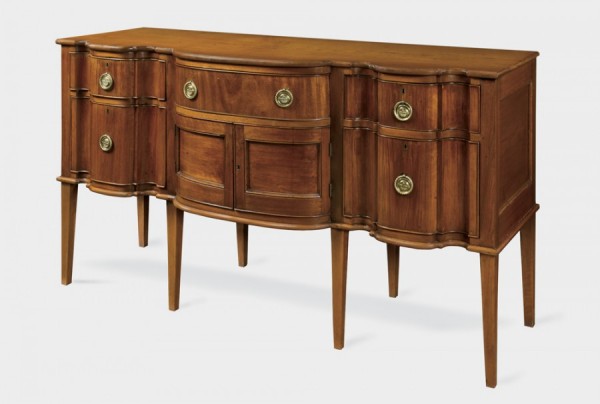
Sideboard associated with the WH group of furniture, northeast, North Carolina, 1810–1820. Walnut with yellow pine, H. 39 1/2", W. 69 1/2", D. 23 3/4". (Courtesy, Historic Hope Foundation; photo, Gavin Ashworth.)
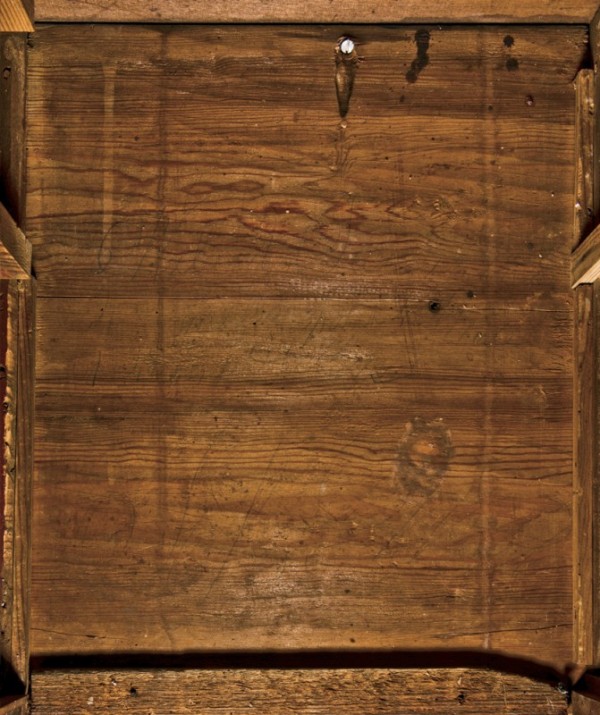
Standard photograph of the inner surface of the back of the sideboard illustrated in fig. 26 showing a large, lengthy, but nearly illegible pencil inscription. (Photo, Gavin Ashworth.)
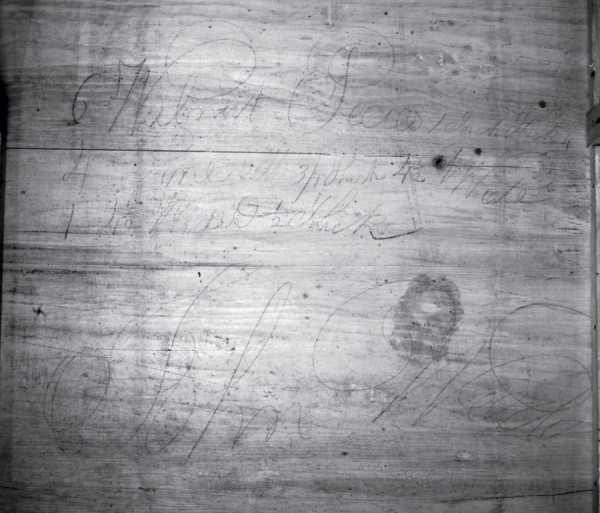
In a reflected infrared image of the inscription illustrated in fig. 27, the handwriting is completely legible. (Photo, F. Carey Howlett.)
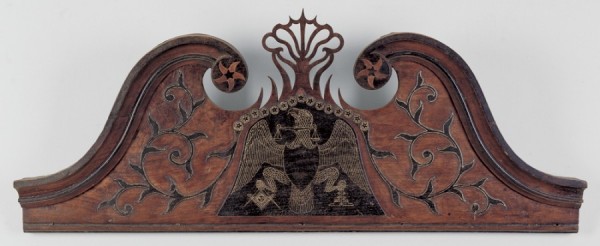
Tympanum board attributed to the WH cabinetmaker, northeast, North Carolina, 1792–1796. Walnut, ebonized ornament and putty inlay. H. 18", W. 44". (Private collection; photo, Craig McDougal.)

Cross-polarization photo of the large chalk inscription on the back of the tympanum board illustrated in fig. 29. (Photo, F. Carey Howlett.)
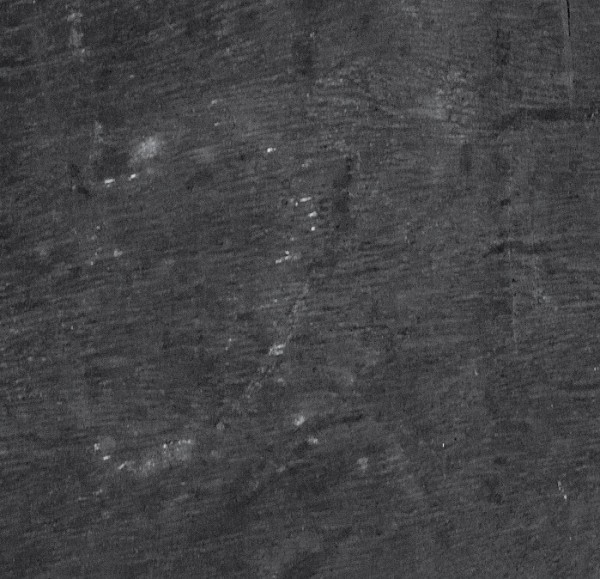
Processed cross-polarization photo of the first letter of the inscription illustrated in fig. 30. (Photo, F. Carey Howlett.)

Processed cross-polarization photo of the name “Haskell” and additional lettering illustrated in fig. 30. (Photo, F. Carey Howlett.)
